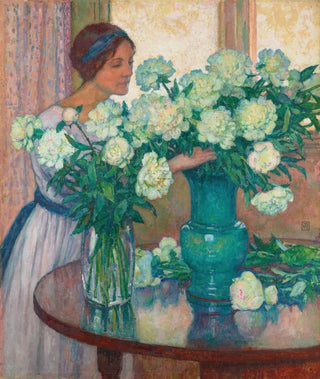Art print | White Peonies - Theo van Rysselberghe


View from behind

Frame (optional)
Art print Les Pivoines blanches - Theo van Rysselberghe – Engaging Introduction
In the vibrant universe of art, some works manage to capture the very essence of beauty and delicacy. "Les Pivoines blanches" by Theo van Rysselberghe falls into this privileged category. This canvas, where light plays with shapes and colors, transports us to a secret garden where each petal seems to whisper forgotten stories. The art print of this iconic piece allows us to rediscover the magic of nature, while highlighting the undeniable talent of the artist. By contemplating this work, we are invited to immerse ourselves in a world where time seems suspended, where every nuance of white evokes unmatched freshness and purity.
Style and uniqueness of the work
The uniqueness of "Les Pivoines blanches" lies in van Rysselberghe's technical mastery, which manages to infuse vibrant life into his flowers. His delicate palette, dominated by bright whites and subtle touches of green, creates a striking contrast that draws the eye. The peonies, symbols of ephemeral beauty, are rendered with such precision that one could almost feel their intoxicating fragrance. The composition, both harmonious and dynamic, reveals a depth that invites exploration. Every detail, every shadow, is carefully thought out, demonstrating a craftsmanship that transcends simple realism to reach a poetic form of expression. It is this ability to marry technique and emotion that gives the work its unique and timeless character.
The artist and his influence
Theo van Rysselberghe, an emblematic figure of the pointillist movement, established himself as a master of color and light. Influenced by artists such as Georges Seurat and Paul Signac, he developed a style that is uniquely his own, combining the rigor of pointillism with personal sensitivity. His work is not limited to simple representation but invites the viewer to feel the harmony and tranquility of nature. Van Rysselberghe also played a crucial role in the advent of modern art in Belgium, encouraging many artists to explore new creative paths. His ability to capture the beauty of

Matte finish

View from behind

Frame (optional)
Art print Les Pivoines blanches - Theo van Rysselberghe – Engaging Introduction
In the vibrant universe of art, some works manage to capture the very essence of beauty and delicacy. "Les Pivoines blanches" by Theo van Rysselberghe falls into this privileged category. This canvas, where light plays with shapes and colors, transports us to a secret garden where each petal seems to whisper forgotten stories. The art print of this iconic piece allows us to rediscover the magic of nature, while highlighting the undeniable talent of the artist. By contemplating this work, we are invited to immerse ourselves in a world where time seems suspended, where every nuance of white evokes unmatched freshness and purity.
Style and uniqueness of the work
The uniqueness of "Les Pivoines blanches" lies in van Rysselberghe's technical mastery, which manages to infuse vibrant life into his flowers. His delicate palette, dominated by bright whites and subtle touches of green, creates a striking contrast that draws the eye. The peonies, symbols of ephemeral beauty, are rendered with such precision that one could almost feel their intoxicating fragrance. The composition, both harmonious and dynamic, reveals a depth that invites exploration. Every detail, every shadow, is carefully thought out, demonstrating a craftsmanship that transcends simple realism to reach a poetic form of expression. It is this ability to marry technique and emotion that gives the work its unique and timeless character.
The artist and his influence
Theo van Rysselberghe, an emblematic figure of the pointillist movement, established himself as a master of color and light. Influenced by artists such as Georges Seurat and Paul Signac, he developed a style that is uniquely his own, combining the rigor of pointillism with personal sensitivity. His work is not limited to simple representation but invites the viewer to feel the harmony and tranquility of nature. Van Rysselberghe also played a crucial role in the advent of modern art in Belgium, encouraging many artists to explore new creative paths. His ability to capture the beauty of






